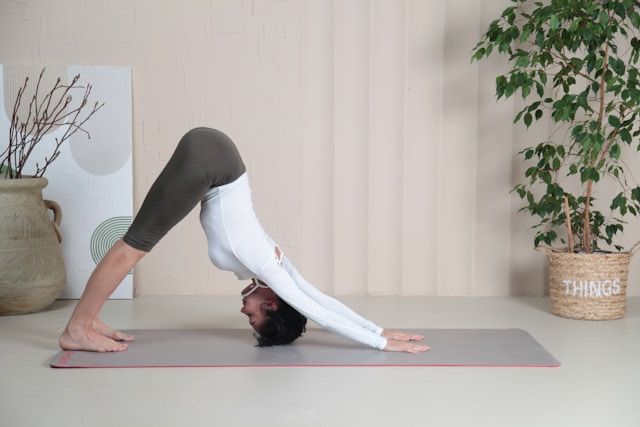Unveil how this foundational yoga pose can enhance strength, mobility, and mental focus in your daily life
The Downward Dog, a cornerstone of yoga practice known as Adho Mukha Svanasana in Sanskrit, transcends mere flexibility benefits, offering a wealth of advantages for both the body and mind. This iconic pose, characterized by its inverted “V” shape, is a multifaceted exercise that strengthens, stretches, and revitalizes the practitioner. Here, we explore the comprehensive benefits of integrating Downward Dog into your yoga routine.
How to Perfect the Downward Dog
Achieving the correct form in Downward Dog is pivotal for reaping its full benefits. Begin in a tabletop position, ensuring your fingers are spread wide for a solid foundation. As you lift into the pose, focus on creating a straight line from your wrists through your shoulders and down to your hips, extending into a peak. Engage your core and leg muscles while aiming to distribute your weight evenly between your hands and feet. Proper alignment and breathing are key to maximizing the pose’s efficacy.
Beyond Flexibility: The Multidimensional Benefits
1. Enhanced Strength: Downward Dog works to strengthen the arms, shoulders, and legs, providing a comprehensive workout that supports everyday activities and overall mobility.
2. Improved Mobility: This pose aids in enhancing the body’s range of motion, particularly in the wrists and ankles, essential for daily tasks and maintaining independence as we age.
3. Boosted Circulation: As an inverted pose, Downward Dog stimulates blood flow throughout the body, including the brain, offering a refreshing energy boost and supporting cardiovascular health.
4. Posture Correction: Regular practice helps to realign the spine, open the chest, and strengthen the core, contributing to better posture and reducing the strain of sedentary habits.
5. Mental Clarity: Serving as a tranquil moment in your practice, Downward Dog can quiet the mind, fostering a state of focused calmness and preparing you for deeper meditation.
Embed from Getty ImagesMuscles Engaged in Downward Dog
Engaging a broad spectrum of muscles, Downward Dog is a full-body exercise. Key areas worked include the deltoids, triceps, rectus abdominis, obliques, hamstrings, and calf muscles. By activating these groups, the pose ensures a balanced strengthening and stretching routine, integral for functional fitness.
Common Mistakes to Avoid
Achieving the optimal Downward Dog involves mindfulness to prevent common errors such as overly straight legs, excessive spine lengthening, or misaligned hands. Ensuring a balance between flexibility and strength, maintaining proper hand placement, and allowing for natural variations in heel placement are crucial for a safe and effective practice.
Embed from Getty ImagesSafety Tips and Modifications
Listen to your body and make adjustments as necessary, especially if dealing with injuries or health conditions. Modifications like bending the knees, using props for wrist support, or widening the hand and shoulder placement can make the pose more accessible and comfortable for all practitioners.
Incorporating Downward Dog into Your Routine
Downward Dog is not just a staple of yoga practice but a versatile pose that can be integrated throughout your day for a quick stretch, strength boost, or mental reset. Its adaptability and broad range of benefits make it an essential exercise for individuals seeking a holistic approach to health and wellness.
